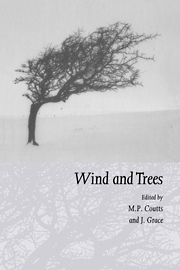Book contents
- Frontmatter
- Contents
- Preface
- List of contributors
- Part I Airflow over topography and in forests
- Part II Mechanics of trees under wind loading
- Part III Tree physiological responses
- 14 Wind-induced physiological and developmental responses in trees
- 15 Responses of young trees to wind: effects on root growth
- 16 Wind stability factors in tree selection: distribution of biomass within root systems of Sitka spruce clones
- 17 Development of buttresses in rainforest trees: the influence of mechanical stress
- Part IV Impacts of wind on forests and ecology
- Part V Risk assessment and management response
- Index
17 - Development of buttresses in rainforest trees: the influence of mechanical stress
Published online by Cambridge University Press: 27 October 2009
- Frontmatter
- Contents
- Preface
- List of contributors
- Part I Airflow over topography and in forests
- Part II Mechanics of trees under wind loading
- Part III Tree physiological responses
- 14 Wind-induced physiological and developmental responses in trees
- 15 Responses of young trees to wind: effects on root growth
- 16 Wind stability factors in tree selection: distribution of biomass within root systems of Sitka spruce clones
- 17 Development of buttresses in rainforest trees: the influence of mechanical stress
- Part IV Impacts of wind on forests and ecology
- Part V Risk assessment and management response
- Index
Summary
Abstract
An experimental study was performed to test the model of buttress development proposed by Claus Mattheck: that the high rates of growth occurring along the top of the junction between the trunk and the lateral roots are stimulated by the mechanical strains set up by wind forces which are concentrated in these regions. Strain gauges were attached around the base of the trunk and the lateral roots of young rainforest trees which were developing buttresses; strains were measured during simulated wind events when the trunk was bent over using a winch. Results supported Mattheck's theory: strains were concentrated along the top of developing buttresses and on the trunk above them – the places of maximum growth – and were negligible on the sides of the buttresses and at the base of the trunk where no growth was occurring. Buttress development seems to be controlled by the mechanical environment of the tree. Once the root system, in which lateral roots are attached to the subsoil well away from the trunk by sinker roots, has formed the growth of buttresses occurs automatically. This produces a mechanically efficient anchorage system in terms of the carbon investment. Trees which do not form buttresses instead transfer forces into the ground using a tap root or sinkers positioned close to the trunk.
Introduction
Root buttresses are a characteristic feature of the trees of lowland tropical rainforest. These huge plate-like structures which are formed around the base of the trunk have been the subject of speculation by generations of biologists who have attempted to discover what function they serve and what influences their development.
- Type
- Chapter
- Information
- Wind and Trees , pp. 293 - 302Publisher: Cambridge University PressPrint publication year: 1995
- 17
- Cited by



